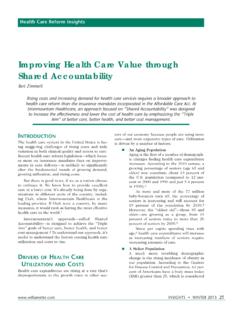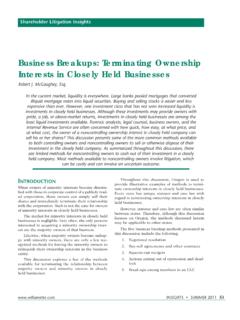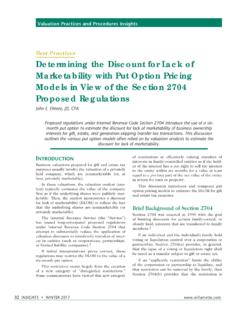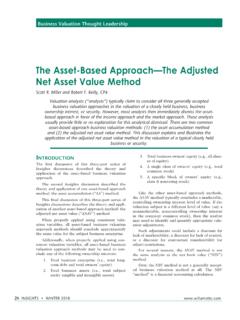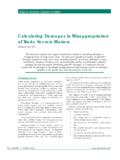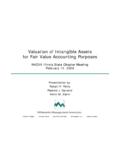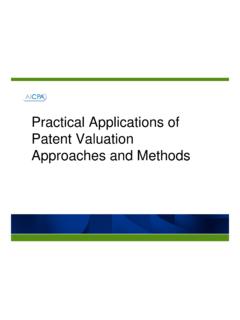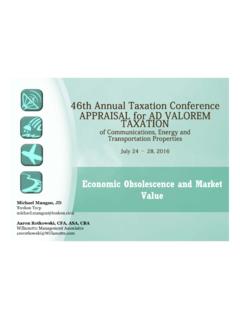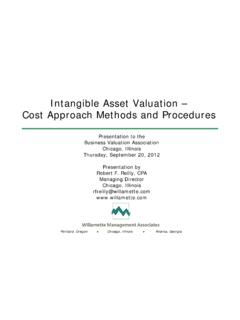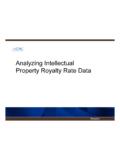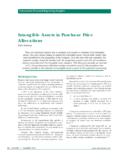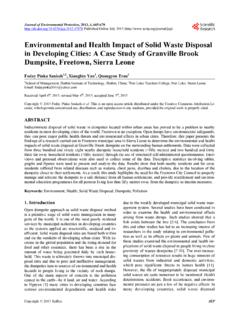Transcription of Discount Rates in a Purchase Price Allocation
1 38 insights summer 2013 www .willamette .comDiscount Rates in a Purchase Price AllocationDavid TurneyTransaction Financial Reporting InsightsThis discussion summarizes the interrelatedness of the weighted average cost of capital and the weighted average return on assets within the context of a Purchase Price Allocation for financial reporting purposes. Failure to understand this fundamental relationship can lead to inaccurate estimates of value for the acquired assets and, therefore, inaccurate reported asset values and amortization expense on the financial statements of the acquirer. The WACC can be viewed as a weighted average of the required Rates of return for the individual assets of the acquired company. The selected intangible asset Rates of return should be reviewed for reasonableness through a weighted average return on assets analysis. Understanding the nature and risk of the expected cash flow (of the enterprise and specific assets) is important to ensuring consistency throughout the discussion considers the interrelatedness of the weighted average cost of capital (WACC) and the weighted average return on assets (WARA)
2 Within the context of a Purchase Price Allocation for finan-cial reporting is important for the analyst performing a pur-chase Price Allocation valuation analysis to under-stand this concept when estimating the appropriate intangible and tangible asset Rates of to understand this relationship can lead to inaccurate estimates of value for the acquired assets and, therefore, inaccurate reported asset values and amortization expense on the financial statements of the discussion provides an overview of the financial reporting Purchase Price Allocation guid-ance, income approach methods used to value businesses and intangible assets, and Discount Rates applied in the income approach 805 overvieWFinancial Accounting Standards Board (FASB) Accounting Standards Codification (ASC) topic 805 provides guidance on the accounting and report-ing that represent business combinations to be accounted for under the acquisition method.
3 The acquirer is required to estimate the fair value of acquired assets. Using the appropriate valuation approaches and methods, the Purchase Price is allo-cated between:1. identifiable assets (including financial assets, tangible assets, and identifiable intangible assets) and2. purchased to ASC topic 805, intangible assets should be categorized by type and separated into two groups:1. Those with an identifiable remaining useful life2. Those with an indefinite lifeGoodwill is not assigned a useful life, but it is tested (at least) annually for impairment. Intangible assets can be grouped into several categories, including: marketing, customer-based, artistic, tech-nology, and .willamette .com insights summer 2013 39 ASC topic 805 uses the fair value definition from ASC topic 820, which defines fair value as the Price that would be received to sell an asset or paid to transfer a liability in an orderly transaction between market participants at the measurement date.
4 Income approachThe three approaches employed in the valuation of assets include: the income approach, the market approach, and the cost approach. The focus of this discussion is on several income approach methods that are used in the business enterprise valuation and intangible asset valuation. This discussion also focuses on the measurement of the Discount rate that is applied within the income approach valua-tion income approach is a valuation method that provides an estimate of the fair value of an asset based on the cash flows that an asset (or business) can be expected to generate over its remaining use-ful Enterprise ValuationThe income approach may be applied through a discounted cash flow (DCF) method. A valuation using the DCF method is based on the present value of estimated future cash flows for the expected life of the asset (or business) discounted at a rate of return that considers the relative risk of achieving that cash flow and the time value of money.
5 The DCF method is often used in estimating the business enterprise value of the acquired the business enterprise value of the acquired company is the initial step in performing a Purchase Price Allocation . This step is performed for several reasons, including the following: To validate that the Purchase Price is repre-sentative of fair value and that it was not a bargain Purchase or overpayment To validate the reasonableness of the overall business cash flow projections to be relied on in applying the income approach to value certain intangible assets To validate the reasonableness of the required Rates of return applied in the valu-ation of the intangible assets To validate that the estimated fair values of the assets are reasonable relative to the business enterprise value of the acquired companyWhen net cash flow to invested capital is used as the measure of income subject to analysis, the Discount rate applied is typically the overall cost of Asset ValuationIn the valuation of intangible assets, the income approach may be applied through the multiperiod excess earnings method (MEEM)
6 , the royalty savings method, or some other discussion describes the MEEM and the royalty savings method. The valuation of identified intangible assets relies on both:1. expected cash flow that is attributable to the subject intangible assets and2. the Discount rate that is applied to that cash Excess Earnings MethodThe MEEM is a method under the income approach used to estimate the value of certain intangible assets. The starting point for the MEEM is generally financial information ( , revenue, profit margin, etc.) derived from the DCF assets often do not produce profits and cash flow without the use of other tangible and intangible assets. Through the application of the MEEM the cash flows of the subject intangible asset can be isolated from the group of expected earnings of the subject intangible asset, or excess earnings, are isolated from the earnings of the group of assets by identifying and deducting portions of the total earnings that are attributable to contributory identification of earnings attributable to the contributory assets is based on the applica-tion of a contributory asset charges (CAC), which represent an economic charge for the use of the contributory assets.
7 The resulting excess earnings (the residual earnings after subtraction of the CAC) are the earnings attributable to the subject intan-gible excess earnings of the subject intangible asset should be discounted to present value at appropriate rate of Savings MethodThe royalty savings method is another method that is sometimes considered an income approach method. This method is often used to estimate the value of certain intellectual property. In the royalty savings method, the value of the intangible asset is estimated to be the present value of the royalties saved because the company owns the intangible insights summer 2013 www .willamette .comViewed another way, the owner of the subject intangible asset realizes a benefit from owning the asset as opposed to paying royalties for the use of the subject intangible asset.
8 By acquiring the asset, the owner is relieved from making royalty after-tax royalty savings of the subject intan-gible asset should be discounted to the present value at an appropriate rate of raTesThe cost of capital can be viewed from three dif-ferent perspectives, as discussed in the following quotations:On the asset side of a firm s balance sheet, it is the rate that should be used to Discount to a present value the future expected cash flows. On the liability side, it is the economic cost to the business of attracting and retain-ing capital in a competitive environment, in which investors (capital providers) care-fully analyze and compare all return-gener-ating opportunities. On the investor s side, it is the return one expects and requires from an invest-ment in a business s debt or equity. While each of these perspectives might view the cost of capital differently, they are all deal-ing with the same oF reTurnThe estimation of an overall rate of return for the acquired company is required before determin-ing the stratification of the Rates of return for the acquired assets.
9 The comparison of the WACC to the WARA allows the analyst to reconcile the Rates of return required by providers of capital with the Rates of return earned by the acquired Average Cost of CapitalThe overall cost of capital is commonly referred to as the WACC. The WACC is calculated as the return on the investment in the acquired company by a market WACC is comprised of a required rate of return on equity which is estimated by a rate build-ing process ( , capital asset pricing model, the build-up model, etc.) and an after-tax rate of return on debt , an analysis of an appropriate long-term market participant capital structure for the acquired company is required. Using an estimated required rate of return on equity capital, an estimated after-tax cost of debt capital, and a market participant capital structure, the WACC of the acquired com-pany can be Rate of Return SelectionIn general, the risk profile of each asset category should be considered when estimating the appro-priate Rates of return.
10 The analyst should consider the liquidity of the assets on the balance sheet on a spectrum from working capital (most liquid) to the intangible assets (least liquid). In addition, the ana-lyst can consider the assets based on their ability to be financed by debt or Appraisal Foundation notes that the risk profile of an entity s assets generally increases as you move down the balance sheet and, accord-ingly, the type of financing available for these assets shifts from debt to equity as the risk profile increases. 2 Given these concepts, it is typical to select a rate of return for working capital at or near the cost of debt (depending on the available debt financing esti-mated with the market participant capital structure and the Purchase Price paid) and a rate of return consistent with the estimated cost of equity for the acquired company s intangible selected asset Rates of return have three uses in the MEEM within the Purchase Price Allocation analysis.
